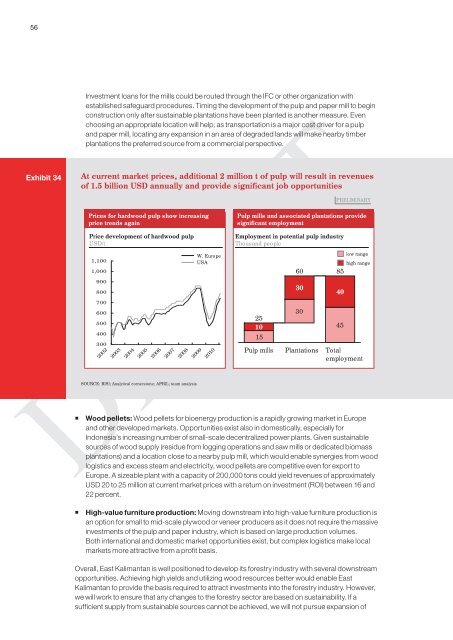East Kalimantan Environmentally Sustainable Development Strategy
East Kalimantan Environmentally Sustainable Development Strategy
East Kalimantan Environmentally Sustainable Development Strategy
You also want an ePaper? Increase the reach of your titles
YUMPU automatically turns print PDFs into web optimized ePapers that Google loves.
56<br />
Exhibit 34<br />
Investment loans for the mills could be routed through the IFC or other organization with<br />
established safeguard procedures. Timing the development of the pulp and paper mill to begin<br />
construction only after sustainable plantations have been planted is another measure. Even<br />
choosing an appropriate location will help; as transportation is a major cost driver for a pulp<br />
and paper mill, locating any expansion in an area of degraded lands will make nearby timber<br />
plantations the preferred source from a commercial perspective.<br />
At current market prices, additional 2 million t of pulp will result in revenues<br />
of 1.5 billion USD annually and provide significant job opportunities<br />
Prices for hardwood pulp show increasing<br />
price trends again<br />
Price development of hardwood pulp<br />
USD/t<br />
1,100<br />
1,000<br />
900<br />
800<br />
700<br />
600<br />
500<br />
400<br />
300<br />
2003<br />
2004<br />
2005<br />
2006<br />
2007<br />
2008<br />
SOURCE: RISI; Analytical cornerstone; APRIL; team analysis<br />
W. Europe<br />
USA<br />
2009<br />
2010<br />
Employment in potential pulp industry<br />
Thousand people<br />
DRAFT<br />
2002<br />
• Wood pellets: Wood pellets for bioenergy production is a rapidly growing market in Europe<br />
and other developed markets. Opportunities exist also in domestically, especially for<br />
Indonesia’s increasing number of small-scale decentralized power plants. Given sustainable<br />
sources of wood supply (residue from logging operations and saw mills or dedicated biomass<br />
plantations) and a location close to a nearby pulp mill, which would enable synergies from wood<br />
logistics and excess steam and electricity, wood pellets are competitive even for export to<br />
Europe. A sizeable plant with a capacity of 200,000 tons could yield revenues of approximately<br />
USD 20 to 25 million at current market prices with a return on investment (ROI) between 16 and<br />
22 percent.<br />
25<br />
10<br />
15<br />
Pulp mills<br />
60<br />
30<br />
30<br />
Plantations<br />
PRELIMINARY<br />
Pulp mills and associated plantations provide<br />
significant employment<br />
85<br />
40<br />
45<br />
low range<br />
high range<br />
Total<br />
employment<br />
• High-value furniture production: Moving downstream into high-value furniture production is<br />
an option for small to mid-scale plywood or veneer producers as it does not require the massive<br />
investments of the pulp and paper industry, which is based on large production volumes.<br />
Both international and domestic market opportunities exist, but complex logistics make local<br />
markets more attractive from a profit basis.<br />
Overall, <strong>East</strong> <strong>Kalimantan</strong> is well positioned to develop its forestry industry with several downstream<br />
opportunities. Achieving high yields and utilizing wood resources better would enable <strong>East</strong><br />
<strong>Kalimantan</strong> to provide the basis required to attract investments into the forestry industry. However,<br />
we will work to ensure that any changes to the forestry sector are based on sustainability. If a<br />
sufficient supply from sustainable sources cannot be achieved, we will not pursue expansion of

















